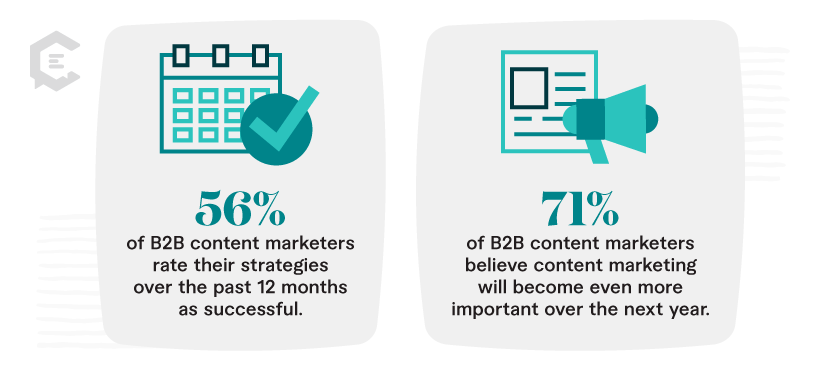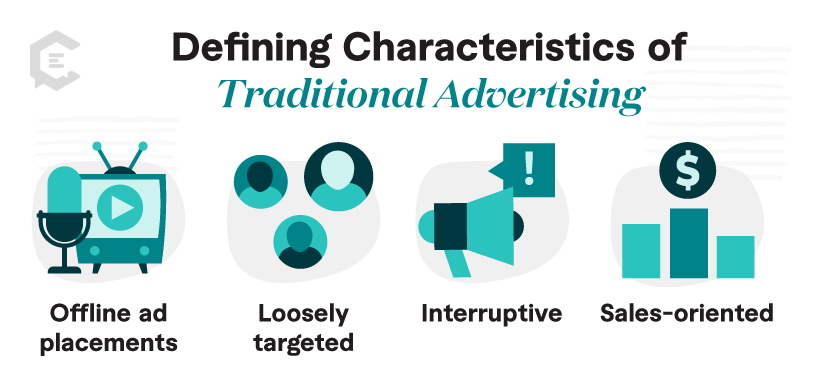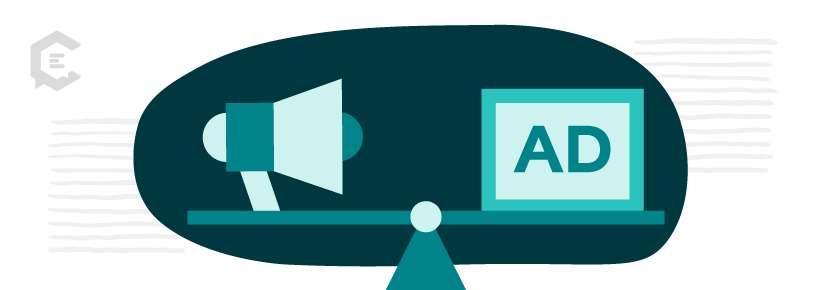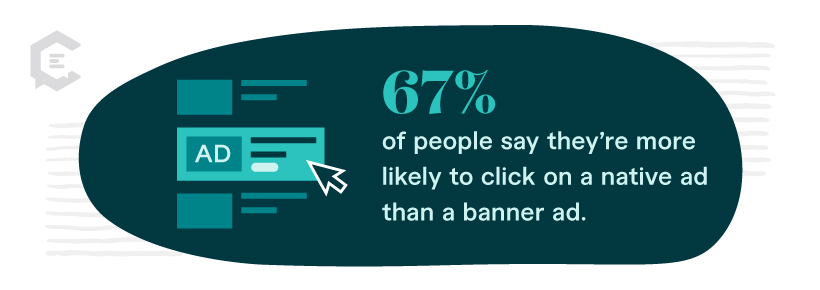Both content marketing and traditional advertising fall under the global umbrella of “marketing.” The point of both is to get the word out about your product or service. But they are very different tools with very other purposes.
Let’s take a deep dive into content marketing vs. traditional advertising in finance. Plus, how to decide which is best for your company.
The role of advertising and content marketing in finance
At one time, advertising was the main tool companies had to inform customers about their service or product.
Radio, print, and television ads all work roughly the same way. They send a one-way message to whoever happens to see them. Ads are very sales-focused, with a direct goal of trying to convince consumers to buy.
Today, businesses have another option: content marketing.
Rather than explicitly trying to sell something, content marketing focuses on informing and entertaining its audience. The goal is building trust and developing lasting relationships, which may lead to a sale.
In the financial industry, trust is essential. Customers must know that yours is the right company to handle their money.
Advertising lets them know specifically what you have to offer. But content marketing helps them understand why they should believe in you. It’s important to understand this distinction when weighing content marketing vs. traditional advertising.
Content marketing in finance
The need for finance content marketing only continues to grow.

According to 2023 research by the Content Marketing Institute, 56% of B2B content marketers rate their strategies over the past 12 months as successful. And 71% believe content marketing will become even more important over the next year.
But exactly what is content marketing, and how are financial companies using it?
Defining characteristics
Content marketing takes many forms, from blog posts to case studies to podcasts. But all types of content marketing share a few basic characteristics:
- Relevant: Each piece of content needs to meet consumers where they are. It should be appropriate to your target audience’s needs, goals, and level of existing familiarity with the topic. Different types of content are also best suited to prospects in different sales funnel phases.
- Useful: Your content needs to provide real value for your target audience. Each piece should help solve a problem, teach them something, or appeal to them somehow.
- Reliable: A content marketing plan aims to build trust and loyalty over time. This means that your content should be truthful and verifiable. It also means that you should release new content on a predictable schedule.
Strengths and weaknesses
Content marketing has some definite advantages and its share of challenges.
Content marketing’s strengths include:
- Brand loyalty: A strong content marketing campaign encourages customers to stick around. Additionally, many will choose your company instead of a competitor when ready to buy.
- Lead generation: As Lindsay Kolowich of HubSpot Academy notes, “The more delighted a visitor is with your content, the more likely they are to click your call-to-action.” This can translate into more leads and conversions.
- Building authority: Over time, high-quality content will establish your credibility. You’ll rank higher in searches while demonstrating your expertise to your site visitors.
The drawbacks of content marketing include:
- Few immediate results: Content marketing is a long game. It’s unlikely to help you meet a short-term sales quota.
- Requires specialized talent: Content marketing demands a unique skill set. You will likely need to either outsource or invest in a targeted in-house team.
- Complex idea generation: A content marketing plan is only as good as the content ideas you generate. But without experience in keyword research and developing a content schedule, you could end up with content that no one wants to see.
Impact and real-world examples
When done properly, content marketing can have a profound impact.

Just look at PayPal’s PayPal Stories website. It shows how the company is helping to support small businesses and meaningful causes worldwide. A stunning 82% of consumers care about aligning a company’s values with their own. Plus, nearly 75% have left a company over conflicting values.
PayPal Stories retains consumer trust and goodwill by showing off the good they do as a company.
Another great example is Stripe. The company’s core business goal is to provide online payment infrastructures to businesses. They offer a helpful Guides section on their site. It walks visitors through complex payment-related topics in an easily digestible way.
This section on their website helps to:
- Establish brand authority
- Build trust with their audience
- Educate consumers on why they need Stripe’s services
Traditional advertising in finance
Of course, traditional advertising also has its place in finance.
Spending on digital advertising surpassed spending on traditional advertising for the first time in 2023. But traditional advertising still accounts for over $200 billion in annual spending in the U.S. alone. Traditional advertising lets you get a targeted, sales-oriented message out quickly to many potential consumers.

Defining characteristics
Defining characteristics of traditional advertising include:
- Offline ad placements: Whether radio, TV, magazines, or billboards, traditional ads appear in offline locations.
- Loosely targeted: You might place a traditional ad during a TV show aimed at your target market or on a billboard along your city’s downtown corridor. But the idea is to reach many people simultaneously, not all of whom fit your target audience.
- Interruptive: While content marketing relies on visitors coming to your site, traditional advertising broadcasts to people doing something else.
- Sales-oriented: While content marketing aims to inform or entertain, copywriters design traditional ads to sell a specific product or service.
Strengths and weaknesses
The biggest advantage of traditional advertising is its ability to communicate its message to a wide group of people quickly. It tends to be short, snappy, and memorable. Its goal is to yield quick results. Over time, traditional advertising also builds brand recognition.
Weaknesses of traditional advertising include the need for more to closely target a specific audience. Typical ads are too short to fully explain a complex topic. And ad buys can be expensive, forcing companies to carefully choose where and when to advertise.
Impact and real-world examples
Of course, traditional advertising has long been the default for building brand loyalty.
Who can forget the Pepsi Challenge? Or Wendy’s “Where’s the Beef?” campaign?
In the financial industry, E-Trade made quite a name for itself with its long-running series of ads featuring a talking, investing baby. Traditional advertising can be highly profitable with a strong budget and clever ad writers.

Balancing content marketing and traditional advertising
Perhaps we’re asking the wrong question.
Rather than looking at content marketing vs. traditional advertising in finance, maybe the better question would be, “How can I balance both?”
The case for an integrated approach
Content marketing and traditional advertising may fall under the same general umbrella. But they serve very different purposes.
Content marketing is all about the long game. Slowly building credibility and trust while helping people understand why they need your product or service. Advertising plays both short and long games. Ads quickly capture people’s attention and sell them something specific. Over time, they can also build brand recognition among the general public.
The two approaches actually work quite well together.
Ads bring people to your website, while strong content keeps them there. And someone who has been following your content might see your ad and decide that now is the time to buy.
Strategies for effective integration
The digital space provides innumerable opportunities to meld advertising with content marketing.

Native ads, or ads that blend in with the content around them, read like a short sales-orientated piece of content. And 67% of people say they’re more likely to click on a native ad than a banner ad.
But to really blend content marketing with advertising, consider “fastvertising.” This is the process of capitalizing on something that’s trending, shooting a quick ad, and releasing it on social media. It’s okay to be bold and edgy, but remember to tie your ad into your overall content strategy.
The goal is to hook people fast and draw them into your content.
A real-world example of successful integration
One of the best real-world examples of “fastvertising” came from Aviation Gin, owned by Hollywood legend Ryan Reynolds. It capitalized on a 2019 Peloton commercial in which a husband gifted his wife a Peloton bike, and she created a video diary as a thank you. Amid the #MeToo movement, the Peloton ad went viral for its alleged sexism.
Aviation Gin swooped in, hiring the woman from the Peloton ad to film a sequel. In this ad, she was guzzling gin with her friends, clearly upset about something. Implying but not directly saying that the relationship with the Peloton guy didn’t work out. Reynolds released the ad on his Twitter with the caption, “Exercise bike not included.”
The post instantly went viral. It generated 10 million Twitter views, over 6 million YouTube views, and 13 billion media impressions. It may also have contributed to the $610 million made later that summer when the Aviation Gin company was sold.

Future trends and predictions
The lines between the online and offline worlds continue to blur. Augmented reality and other technologies gain traction. And digital advertising has become its own marketplace.
Digital marketers blend traditional advertising strategies with content marketing best practices.
Don’t just settle for one or the other! Now is the time for financial companies to find ways to balance and even integrate these very different ways of getting the message across.
Are you ready to embrace the future of content marketing in finance? Learn how the expert finance writers at ClearVoice can take your content to the next level!



